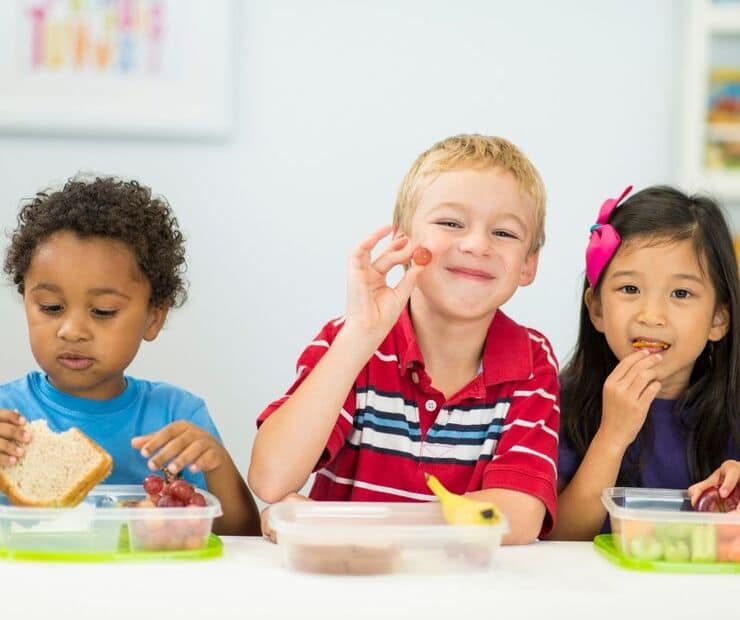
Young children have opportunities for learning and developing during mealtime. Teachers and homeschooling parents can make lunchtime more valuable for preschoolers. Transform meals into mini-lessons as you can focus on children individually. Young kids need routines, and pre-k is the ideal age to model behavior. Lunchtime gives teachers the perfect opportunity to serve up some learning and nutrition. By not rushing meals, you’ll get to enjoy talking to the children and learning together. An excellent resource guide to complement this blog is Science, Math, and Nutrition for Toddlers.
Mealtime for Preschoolers Teach These Valuable Lessons:
Manners
- Teach young children to chew with their mouths closed and not speak with a mouth full of food.
- Get preschoolers in the habit of saying, “please, thank you, you’re welcome, and excuse me.”
- Ask the students to pass food politely and help them develop motor skills.
- Kids can develop motor skills by using utensils to pick up their food. Older pre-k children can also learn the art of using chopsticks, which many adults can’t master.
- Have children cut their food using a fork and knife.
- Show preschoolers and remind them to keep their elbows off the table.
- Have them appreciate lunchtime and sit still as they eat.
Independence
- Young children can learn how to serve themselves. Kids can grab their plates and advance into pouring drinks.
- During mealtime, discuss feelings, experiences, and plans with the students.
- Choose healthy foods and drinks to serve and teach preschoolers about nutrition.
- Let young children try foods they may not have tried before. You’ll see what they like and what they don’t like. Introducing new foods can be an excellent opportunity for lessons. Kids may love certain fruits, vegetables, or cultural foods.
- Allow students to enjoy lunchtime and look forward to the routine.
- As a child passes food, teach them how to distinguish their left from their right.
- Guide pre-k students as you show them how to do things for themselves.
Hygiene and Health
- Before and after eating, kids can clean the table with a damp cloth.
- Have preschoolers wash their hands before and after mealtime.
- If children have to cough or sneeze, show them how to turn away and cover their mouth and nose.
- Be sure the young students know to throw away any food that falls on the floor. The five-second rule doesn’t apply when dealing with preschoolers.
- Place any dirty utensils, cups, and plates where they belong afterward. Kids can learn what and how to reuse, recycle, or dispose of depending on the materials.
- Show children the difference between serving spoons and ones used for eating.
- Have preschoolers wipe their face and hands with napkins, wipes, or paper towels.
- Teach the kids to take small bites and completely chew the food before swallowing.
Have Conversations
- Preschoolers can hone their social skills by establishing eye contact when speaking.
- Teach young children about the tone of voice and that it’s impolite to be loud while eating.
- Engage in small talk to build social/emotional developmental skills.
- Preschool students can learn how to listen as others talk during a meal.
- Name and discuss foods and their groups.
- Have them use their classmates’ names.
- If they need someone’s attention, have them ask politely.
- Openly discuss what they like and dislike and ask why.
- Show young children how to follow directions and respond when called up.
Develop Fine and Gross Motor Skills
- When they clean their hands, they’ll turn on the faucet, pump soap, and dry their hands.
- Preschoolers will hone their skills as they set the table and fold napkins.
- Have young children successfully learn how to pour liquids without spilling.
- Kids can clean up spills and the area after mealtime.
- Motor skills further develop as they serve themselves food with utensils. Kids can use knives to cut food or spread toppings.
- Teach preschool students how to pick up finger foods correctly.
- Pass and serve bowls or pitchers to another person.
Teach Math During Mealtime
- Preschoolers can learn how to count during lunchtime. Teachers can ask how many things are at the table while eating.
- Teach students one-to-one concepts when setting the table. Kids can place one of each utensil and a napkin.
- Pre-k children can learn geometry and shapes. Take a folded napkin and question students about it.
- Preschoolers can learn and understand positional prepositions. Teach “next to, under, over, near, behind, between, on, off, in, out, in front of, and below.”
- Teach fractions when you cut a sandwich in half or into quarters.
- Measure liquids with beverages.
- Discuss shapes, sizes, and differences of food with preschoolers.
